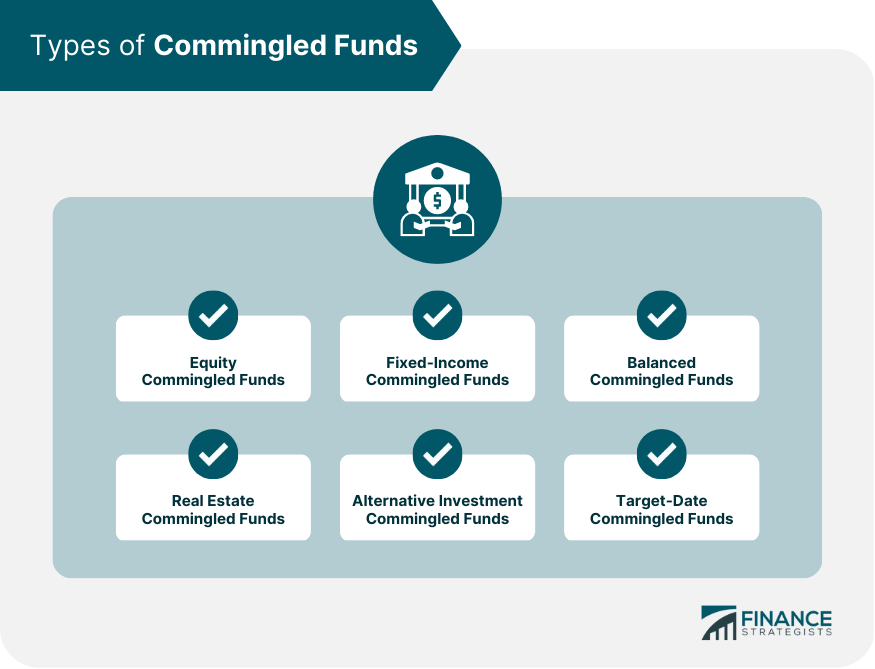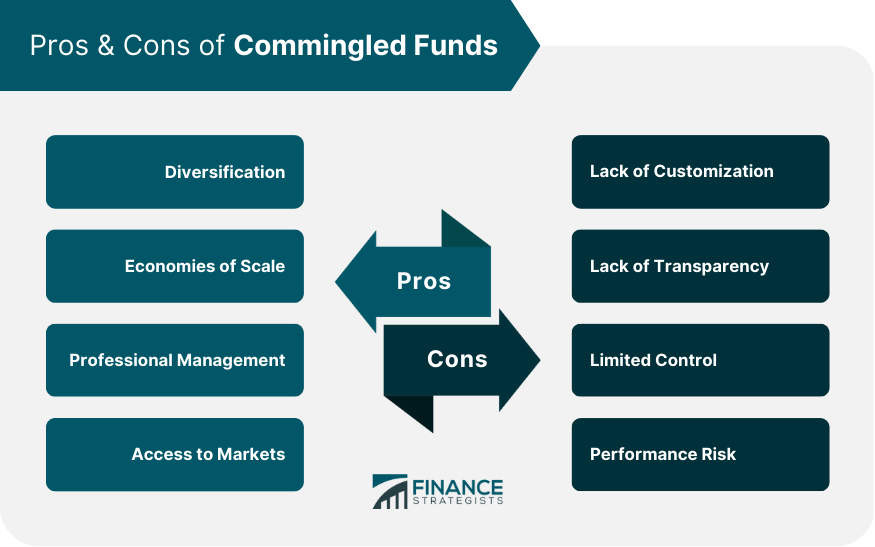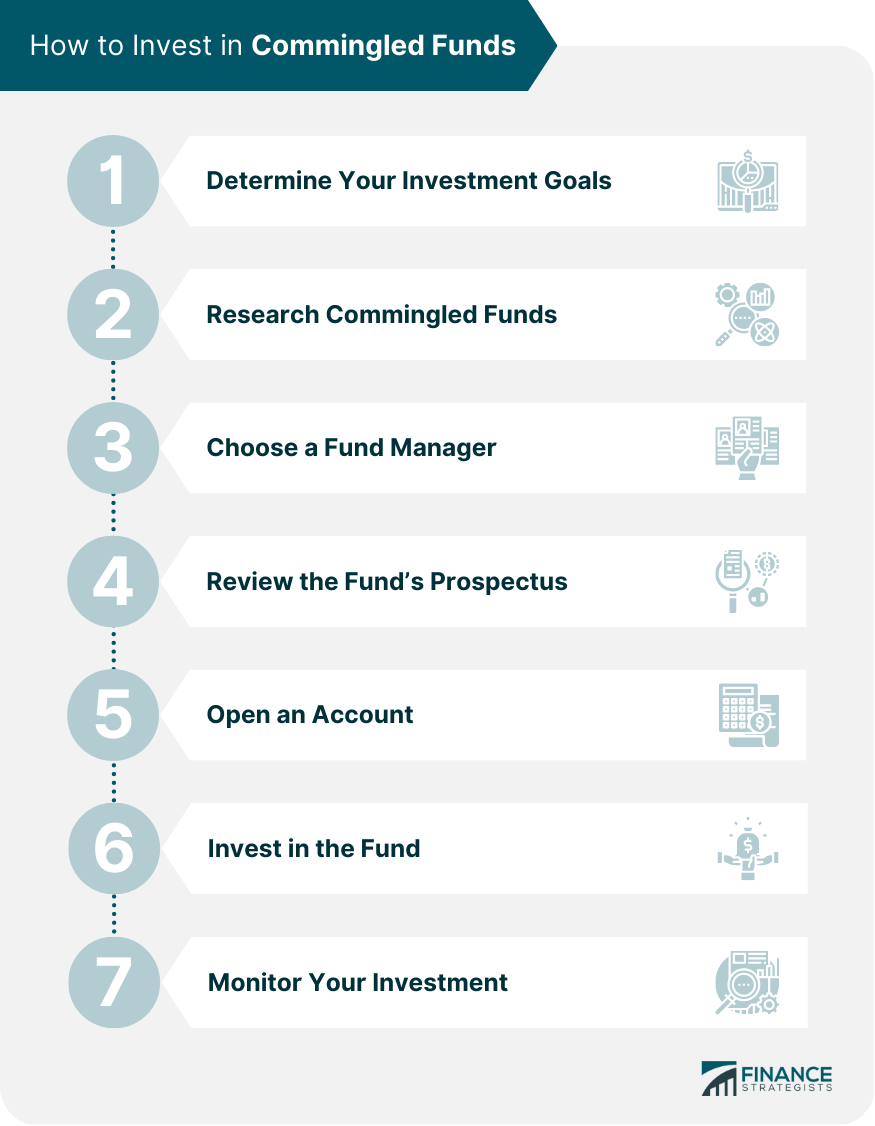Commingled funds, also known as pooled funds, are investment vehicles that pool together money from multiple investors to create a single investment portfolio. These funds are managed by professional investment managers who make investment decisions on behalf of the investors. The funds can invest in a variety of asset classes, including stocks, bonds, real estate, and alternative investments. Commingled funds are typically used by institutional investors, such as pension funds, endowments, and foundations, but can also be available to individual investors. The investment strategy and asset allocation of the fund are typically set by the fund manager and may be adjusted over time based on market conditions and investment objectives. The fund manager is responsible for buying and selling securities within the fund, with the aim of generating returns for investors. The structure of commingled funds allows for greater diversification and economies of scale, which can potentially lead to higher returns and lower costs for investors. These shares can be bought and sold on a daily basis, providing liquidity and flexibility for investors. Have questions about Commingled Funds? Click here. Commingled funds can invest in a variety of asset classes, including stocks, bonds, real estate, and alternative investments. Here are some common types of commingled funds: Equity commingled funds invest in a portfolio of stocks and equity securities, aiming to generate long-term capital appreciation. These funds invest in fixed-income securities, such as bonds, aiming to generate regular income for investors. Balanced commingled funds are funds that invest in a mix of equity and fixed-income securities, aiming to achieve a balance between capital appreciation and income generation. This type of fund invests in a portfolio of properties or real estate-related securities, aiming to generate income and capital appreciation from the real estate market. These funds invest in non-traditional assets, such as hedge funds, private equity, and commodities, aiming to achieve higher returns and diversification. This kind of fund is designed for retirement planning, investing in a mix of equity and fixed-income securities with a target date for retirement in mind. The asset allocation becomes more conservative as the target date approaches. Listed below are the advantages of investing in commingled funds: Commingled funds invest in a diversified portfolio of securities, which helps reduce the risk of individual security losses. By pooling the investments of many investors, commingled funds can diversify their portfolio across various asset classes, sectors, and regions. This diversification helps to spread the risk of losses and minimizes the impact of market volatility. As a result, investors can benefit from a more stable and consistent performance over the long term. By pooling together money from multiple investors, commingled funds can benefit from lower fees, transaction costs, and other expenses than investing individually. This is because commingled funds can negotiate better deals with brokers and other service providers. This is because they represent a larger pool of assets. As a result, investors can benefit from lower fees and expenses, which can increase their returns and lead to a more cost-effective investment. Commingled funds are managed by professional investment managers who have the expertise, resources, and experience to make informed investment decisions. These managers analyze market trends, assess risk, and select securities that align with the investment objective. This professional management can lead to better returns, as the investment decisions are based on extensive research and analysis. Professional management is particularly crucial for investors who do not have the time or expertise to manage their investments. Commingled funds provide investors with access to a broader range of markets and securities than they might otherwise have access to. This can include global markets, as well as specialized or niche markets that may be difficult for individual investors to access. By investing in a commingled fund, investors can benefit from the expertise of the fund manager and gain exposure to a wider range of securities and markets than they might be able to access on their own. Below are the disadvantages of commingled funds that must be considered: Commingled funds are designed to meet the needs of a broad range of investors, and as such, investors may not be able to tailor the fund to their specific investment objectives, risk tolerance, and preferences. The fund manager sets the investment strategy and asset allocation, and investors have limited control over the individual securities in the portfolio. As a result this can limit their returns and increase their risk. Another disadvantage of commingled funds is the lack of transparency. Commingled funds are not required to disclose their holdings publicly, which can make it difficult for investors to fully understand the risks and performance of the fund. Investors may not have access to information about the individual securities in the portfolio, the fees and expenses charged by the fund, or the fund's trading activity. This lack of transparency can limit investors' ability to make informed investment decisions and can increase their risk. Investors in commingled funds have limited control over the individual securities in the portfolio and the investment decisions made by the fund manager. Investors may not be able to adjust the asset allocation of the fund to meet their changing investment goals or risk tolerance. Additionally, investors may not be able to exit their positions in individual securities in a timely manner, which can increase their risk and limit their ability to manage their investments effectively. While commingled funds are managed by professional investment managers, they are still subject to market fluctuations and other risks that can impact their performance. If the fund manager makes poor investment decisions or if market conditions change, the value of the fund may decline, and investors may lose money. The following are some steps on how to invest in commingled funds: Before investing in a commingled fund, it is important to determine your investment goals, risk tolerance, and time horizon. This will help you choose a fund that aligns with your investment objectives. Research commingled funds that align with your investment goals, paying attention to factors such as investment strategy, historical performance, fees and expenses, and regulatory compliance. Once you have identified a commingled fund that aligns with your investment goals, research the fund manager and their investment approach to ensure that they have the expertise, resources, and experience to make informed investment decisions. Before investing in a commingled fund, review the fund's prospectus, which provides important information about the fund's investment strategy, fees and expenses, risks, and performance. Once you have selected a commingled fund, open an account with the fund manager or their authorized distributor. You may be required to provide personal and financial information, such as your name, address, Social Security number, and investment amount. You can invest in the commingled fund by purchasing shares. The minimum investment amount may vary depending on the fund manager and investment objective. After investing in a commingled fund, monitor your investment regularly to ensure that it continues to align with your investment goals and risk tolerance. Review the fund's performance, fees and expenses, and regulatory compliance to ensure that you are achieving your desired returns and that the fund is operating transparently and responsibly. The following are some common investment strategies for commingled funds: The active management strategy involves a professional investment manager making active investment decisions to buy and sell securities with the aim of generating higher returns than the market. This strategy involves investing in a portfolio of securities that tracks a specific index, such as the S&P 500, with the aim of matching the returns of the market. Factor-based investing is investing in securities that exhibit certain factors, such as value, growth, or momentum, with the aim of generating higher returns than the market. This strategy involves investing in a mix of asset classes, such as stocks, bonds, and commodities, with the aim of achieving diversification and reducing risk. Global investing involves investing in securities across multiple countries and regions, with the aim of achieving geographic diversification and potentially higher returns. Commingled funds are investment vehicles that pool together money from multiple investors to create a single investment portfolio. These funds are managed by professional investment managers who make investment decisions on behalf of the investors. The funds can invest in a variety of asset classes, including stocks, bonds, real estate, and alternative investments. Commingled funds are typically used by institutional investors, such as pension funds, endowments, and foundations, but can also be available to individual investors. Commingled funds offer a range of advantages to investors, including diversification, economies of scale, professional management, and access to markets. However, they also have some disadvantages, such as a lack of customization, lack of transparency and limited control. It is important for investors to carefully consider their investment goals, risk tolerance, and time horizon before investing in a commingled fund to ensure that it aligns with their investment objectives. Investors can invest in commingled funds by determining their investment goals, researching commingled funds, choosing a fund manager, reviewing the fund's prospectus, opening an account, investing in the fund, and monitoring their investment regularly. Ultimately, investors can consult a wealth management specialist about their investment and can receive proper guidance and support on which steps to take.Overview of Commingled Funds
Types of Commingled Funds
Equity Commingled Funds
Fixed-Income Commingled Funds
Balanced Commingled Funds
Real Estate Commingled Funds
Alternative Investment Commingled Funds
Target-Date Commingled Funds

Advantages of Commingled Funds
Diversification
Economies of Scale
Professional Management
Access to Markets
Disadvantages of Commingled Funds
Lack of Customization
Lack of Transparency
Limited Control
Performance Risk

How to Invest in Commingled Funds
Determine Your Investment Goals
Research Commingled Funds
Choose a Fund Manager
Review the Fund's Prospectus
Open an Account
Invest in the Fund
Monitor Your Investment

Investment Strategies for Commingled Funds
Active Management
Passive Management
Factor-Based Investing
Multi-Asset Investing
Global Investing
Final Thoughts
Commingled Funds FAQs
Commingled funds are investment vehicles that pool together money from multiple investors to create a single investment portfolio.
Commingled funds offer advantages such as diversification, economies of scale, professional management, and access to markets.
Commingled funds have some disadvantages, such as lack of customization, lack of transparency, limited control, and performance risk.
To invest in commingled funds, you can determine your investment goals, research commingled funds, choose a fund manager, review the fund's prospectus, open an account, invest in the fund, and monitor your investment regularly.
Commingled funds come in various types, including equity commingled funds, fixed-income commingled funds, balanced commingled funds, real estate commingled funds, alternative investment commingled funds, and target-date commingled funds.
True Tamplin is a published author, public speaker, CEO of UpDigital, and founder of Finance Strategists.
True is a Certified Educator in Personal Finance (CEPF®), author of The Handy Financial Ratios Guide, a member of the Society for Advancing Business Editing and Writing, contributes to his financial education site, Finance Strategists, and has spoken to various financial communities such as the CFA Institute, as well as university students like his Alma mater, Biola University, where he received a bachelor of science in business and data analytics.
To learn more about True, visit his personal website or view his author profiles on Amazon, Nasdaq and Forbes.















